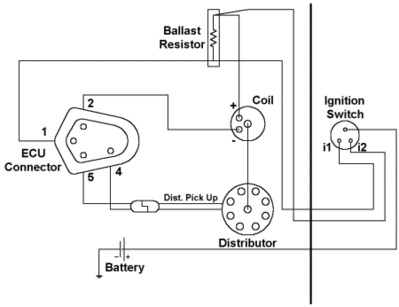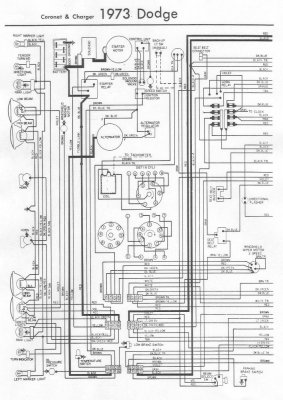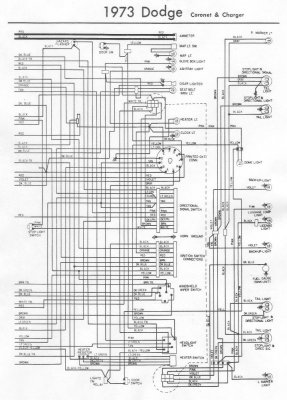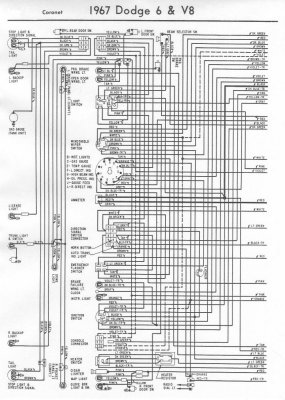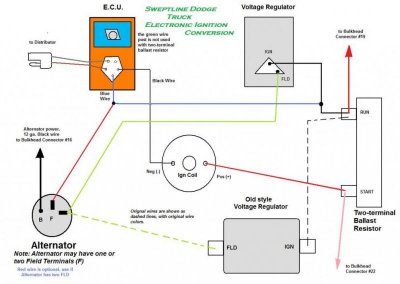RoadWarrior
Well-Known Member
Hey guys. Been gone awhile. New job, moving, all that fun stuff. Got my 67 Belvedere "Hellvedere" out and began to rewire it. I am using the EZ wire 21 circuit harness because it was really cheap. Removed all the fuses and wires I don't need. I know its an overkill but you never know what I will add down the road. Anyway here is my question:
I have a 60amp duel field alternator. Brand new electronic voltage regulator. 4 wire orange ecu with 2 peg ballast resistor. Ign peg from the voltage regulator is spliced to alternator field, ign #1 and blue wire from ecu. other field on volt reg to other field on alternator. Now before Ign#1 on the switch went straight from switch to Ball. Res. But with the new harness the coil wire goes through the fuse box then to the ballast resistor. Now key on to acc I have 12 volt to voltmeter. Turn key other way to run position I pop the 30 amp fuse everytime. I have 12.26 volts from ign 1 with key in "run". I never had a fuse before should I bypass fuse box and run it straight to the ballast resistor? My ign #2 goes straight to positive side bypassing coil as it should.
All I can think of are the "universal" wires I won't be using. I made sure nothing is touching ground. Also there is the alternator exciter wire I did not connect to alternator because I am already using the 2 field terminals. Should I use this to splice into voltage regulator instead of my ign#1 for the 12 volt source? there is a 10 gauge "solenoid power" wire from fuse box I am not using because mine gets power straight from battery. I am assuming it means starter solenoid. "Alt power" to battery post on starter relay for fuse power.
I ignored the instructions that came with it. They made no sense. I drew up my own but didn't expect to blow my coil fuse over and over. Now my car did start having problems in the Run position which started this project (bulk head was a mess). So maybe bad ign switch? Any thoughts? like I said when I switch the key to run (not start) I have 12.26 volts on the ign #1 post on my voltmeter.
Hope that wasn't to long. I am on disability for a broken wrist so have nothing but time. Thanks again guys.
I have a 60amp duel field alternator. Brand new electronic voltage regulator. 4 wire orange ecu with 2 peg ballast resistor. Ign peg from the voltage regulator is spliced to alternator field, ign #1 and blue wire from ecu. other field on volt reg to other field on alternator. Now before Ign#1 on the switch went straight from switch to Ball. Res. But with the new harness the coil wire goes through the fuse box then to the ballast resistor. Now key on to acc I have 12 volt to voltmeter. Turn key other way to run position I pop the 30 amp fuse everytime. I have 12.26 volts from ign 1 with key in "run". I never had a fuse before should I bypass fuse box and run it straight to the ballast resistor? My ign #2 goes straight to positive side bypassing coil as it should.
All I can think of are the "universal" wires I won't be using. I made sure nothing is touching ground. Also there is the alternator exciter wire I did not connect to alternator because I am already using the 2 field terminals. Should I use this to splice into voltage regulator instead of my ign#1 for the 12 volt source? there is a 10 gauge "solenoid power" wire from fuse box I am not using because mine gets power straight from battery. I am assuming it means starter solenoid. "Alt power" to battery post on starter relay for fuse power.
I ignored the instructions that came with it. They made no sense. I drew up my own but didn't expect to blow my coil fuse over and over. Now my car did start having problems in the Run position which started this project (bulk head was a mess). So maybe bad ign switch? Any thoughts? like I said when I switch the key to run (not start) I have 12.26 volts on the ign #1 post on my voltmeter.
Hope that wasn't to long. I am on disability for a broken wrist so have nothing but time. Thanks again guys.

